

 |
 |
This observing session was as tough as it was exciting. The weather forecast looked good with clear skies and the possibility of a severe frost so I knew I was going to see some action. I decided to do an all night session because this has always been my custom with the Geminids each year. Before I go any further I would like to make a small complaint about the negative information given out by various sources on the internet. On the days leading up to the night of maximum (December 13/14th) I was doing a little research on the net about this shower and was surprised to see some web sites informing the public about the event in a manner which gave the impression that it wasn't worth watching, headlines like ''Meteor shower washed out by full Moon'' was one example. I will not mention the names of these wes bites but I felt extremely annoyed when I read the information. So to set the record straight, NEVER let anyone tell you that a meteor shower isn't worth watching because there is a bright Moon in the sky. Anyone, or any society, who trumpets this message in public do not have any experience observing meteor showers in the said conditions. Some of the best meteor activity I have ever seen over the years has occurred under intense moonlight. So, with that off my chest let's begin...
I'm well behind on doing this report so I'm going to keep it short. In Summary I ended up doing a seven hour watch from 00.00 to 07.00 UT. Since photography was my primary goal I decided to keep note-taking to a minimum so I just recorded the amount of Geminids observed each hour. I ended up doing photographic meteor patrols from three different locations near Maghera. For the first I stayed at home and tried to catch what I could from the back garden, then I moved out to two country locations. By the end of the night I had recorded 99 Geminid meteors which I considered to be a respectable amount considering the presence of Moonlight. I was also only looking at one sector of sky because the camera was trained in that direction so I must have missed many more. The highlight of the night was the impressive fireball activity which I will get to soon.
I actually went out earlier in the evening to a country location with the intention of getting the feel for the sky and gauge the activity. It was bitterly cold with a moderate frost on the ground. I was glad of this in a way because the grass was dry and hard. I prefer this to wet grass which really eats up your energy in a big way. There was quite a bit cloud blowing in from the NW on a bone chilling breeze which produced some light sleet showers. There was plenty of clear sky between the bands though so there was never a time when I couldn't see stars. The waning full Moon (1 day after full) was in Gemini not far from the radiant itself. The Moon was surrounded by a series of lovely colourful coronae of various sizes and intensities which was great to watch.
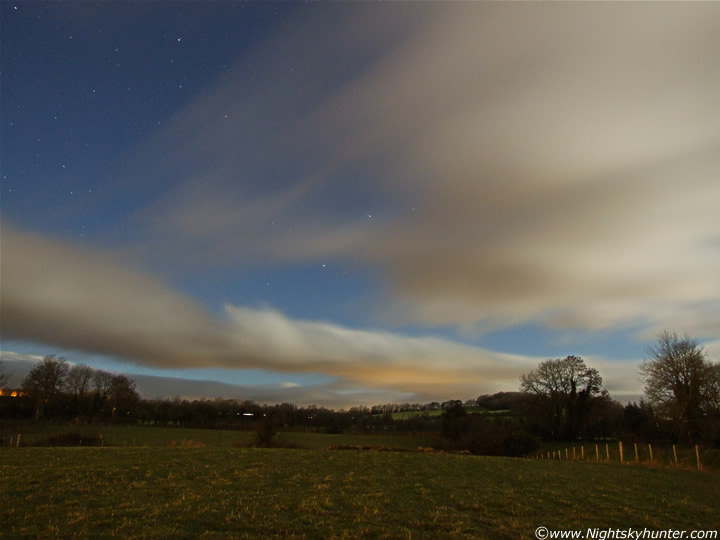 |
This is one of several patrol images I took from this location looking N. I thought that roll of cumulus looked very nice as it swept across the sky from the NW (L to R). It felt very special and atmospheric under this dynamic and constantly changing sky because once the cloud passed over the Moon it looked like someone had dimmed the lights, the field was suddenly plunged into darkness. Then when the cloud cleared the Moon the area was suddenly bathed in brilliant white light. It was so bright I could see my shadow cast across the field with such clarity that it may as well have been daylight. The Moon itself is out of frame and behind my R shoulder. The stars straight ahead belong to Ursa Major. The wide visual double Alcor and Mizar can be seen at that 12 o'clock position. To the upper L is Ursa Minor and Draco. Street lights behind me cast a warm glow over the grass but that's an illusion thanks to the exposure. In reality the grass was white with frost. At this time I was really just trying to figure out what kind of exposure I could get away with for meteor patrolling under such a bright sky. I decided that I would keep the ISO at 400 and stop the aperture down to maintain a lengthy exposure time to increase my chances of catching a meteor.
I spent one hour out here and I hadn't seen a single meteor at all which was very disappointing. I was very tempted to forget about the shower and stay indoors. The cold was really getting to me because up to this point in time I had been having too many late nights which had completely altered my sleep pattern, and as a result I was beginning to get those shivers one gets due to a lack of rest. I decided to change my strategy since the activity was poor. I would go back home and get some rest then resume meteor watching when the radiant got higher. This was exactly what I did. I went to bed and awoke at 23.30 UT. By 00.00 I was out again. I had made a good decision to get some rest because now I was buzzing with energy, felt much warmer, and was focused on a long night of observing. Since it would be a long night I decided I would spend the first half in my backyard.
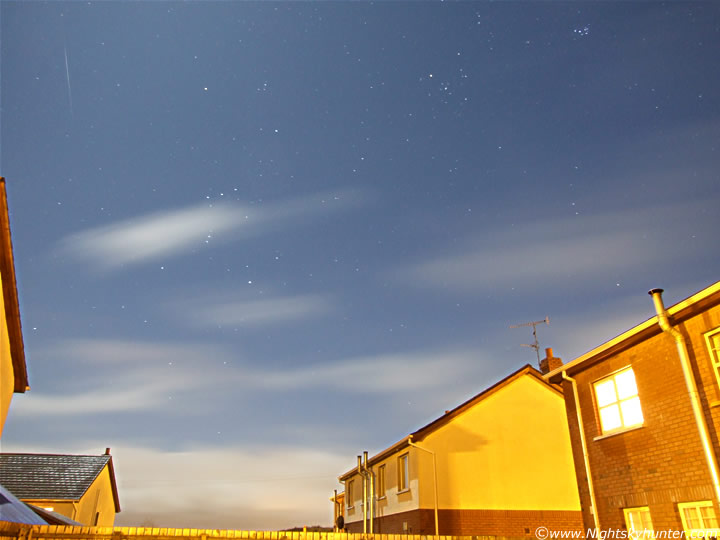 |
My hourly observations began from midnight onwards. The sky was now in excellent form with great transparency. Other than some fleecy cloud drifting over, the sky was perfect, calm, and quiet. I began taking patrol images at ISO400, 30 sec's at F/3.2 using a 28mm lens. This is facing S which was my default area simply because all the other compass points had street lights which you can see casting their yellow/orange sodium glow onto the houses here. Of course the exposure exaggerates this colour and magnitude. Orion and Lepus are L of centre, Monoceros and Canis Major to the lower L. Upper R is Taurus with the Hyades and Pleiades. The Moon was just above the frame to the top L so I had to keep the camera low so it wouldn't enter the frame.
I began to see meteors straight away. It was at this point that I realized the Geminds would put on a great show. Soon the thrill of seeing a meteor changed to constant excitement as more and more burnt up in the atmosphere. All of them I had seen at this point were bright, one even flared up within 1 degree of the Moon itself. The above image was my first catch of the night. This Geminid meteor was mag +1.5, silver in colour, with a slight flare at centre. It shot straight down from the radiant passing through southern Gemini into Monoceros. When the exposure stopped I had a look at the LCD screen and was delighted to see that meteor trail. I was hooked now. I glanced up and saw a mag -5 fireball over the fence in Canis Major. I began taking images again in a hurry!
I began to see what I call 'chasers'. That is, two or more Geminids shooting across the sky at the same time one behind the other, and in this case, separated by 20 degrees of sky. This was repeated many times during the night. At one stage I seen three Geminids in two sec's.
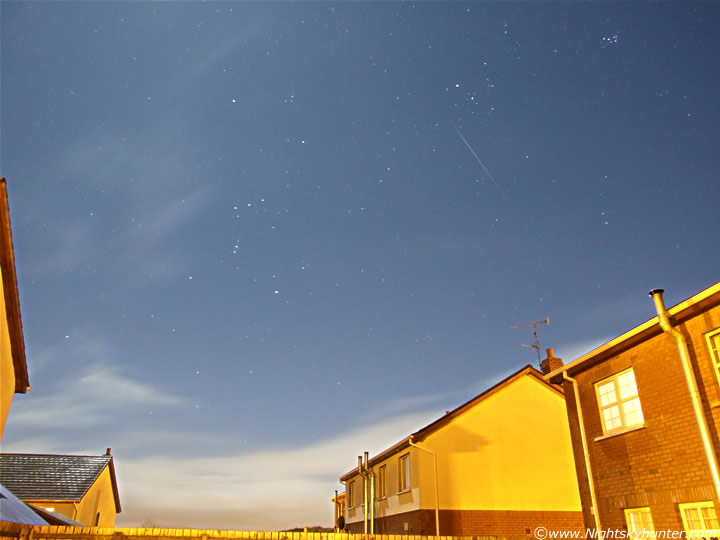 |
Another capture. There should actually be three meteors in this image because a pair of chasers burned up in Lepus which was followed by a mag +1.0 meteor in Taurus. The brighter meteor was recorded however the fainter pair where not present. You can see how much the sky has rotated westward between the above two images. I ended up catching two more meteors from this location but I only included the above two because there are the best of bunch. My camera was absolutely freezing at this point and I feared the batteries would die in a hurry in such cold conditions. I stayed out here for a long time and since I was close to home I would pop inside and make a hot mug of tea. I just stood at the back door watching meteors with Christmas music playing behind me on the CD player which was very atmospheric. I took my camera in a few times to warm up and even put the batteries back on the charger for a little burst. Feeling invigorated by the good meteor activity I decided that it was time to head out to a better location in the hope of getting a more photogenic image.
It was now the early hours of the morning so I began to walk out the main road looking for a good spot. A nice 0 mag Geminid in Draco above the road on the horizon made me quicken my pace. It felt so surreal out here at this time of the night. The road, hedges, and rooftops were white with a crisp frost and looked more like a Winter landscape with the brilliant moonlight reflecting off it. The white was periodically broken by the warm multicoloured lights on outdoor Christmas trees located in the gardens of several homes. I kept walking deeper into the country, soon the warm glow was gone, and the trees got thicker and darker. I ended up at my favourite location on high ground looking over the mountains. Once at the top I caught my breath and took in the view. Within a few min's I had seen two mag -5.0 fireballs burn up low in the NW. I would love to catch a bright one over the town lights, so I decided I would spend an hour or two here trying to do just that. Then with horror I noticed something was wrong. My camera wouldn't connect to the head of the tripod, in fact, the quick release bracket which connected the camera was gone. I had left it on the kitchen table at home when I was recharging the batteries. That was stupid!!!. I had never made this mistake before but now it had to happen on the night of the Geminids!, it was not as if I would go and get it because it took me a long time and much effort to get out here. It was 03.00 UT in the morning and there was no way I had come out here for nothing so I decided to improvise.
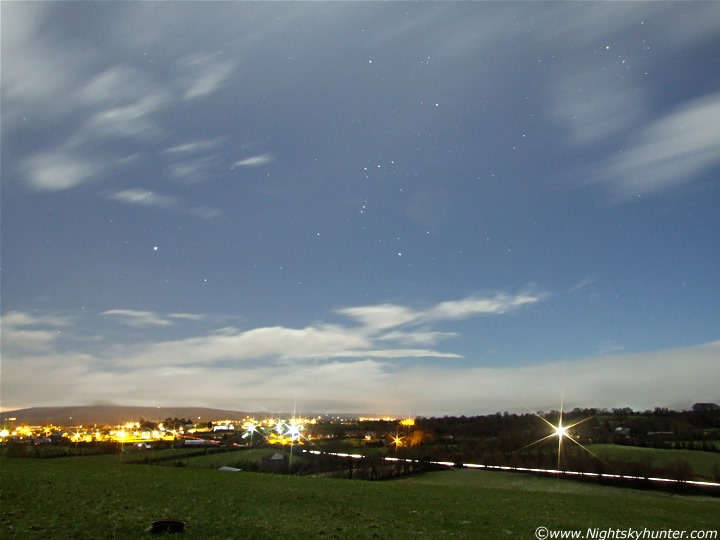 |
I leveled the tripod head, set the camera gently on top, then using the camera's neck strap I wrapped it around the body and tripod head, and tied it on as best I could. It seemed to work so I began taking images. My patience was getting tested in less than a min because when I tilted the camera upwards in a slight vertical direction the camera would slowly slip. Above is one of approx 30 exposures I took at the time. The town lights to the L are a little soft looking, this was because the camera was slipping in that direction. There was only a few late night drivers on the road which provided a nice car trail during the integration. Orion above, Hyades to the upper R, and Canis Major with Sirius to the L. That long white band of cloud to the R is producing sleet showers over the Sperrin Mountains. Some of them made it up here so I packed the camera away, waited for them to pass, then resumed patrolling. During this period I seen several Geminids shoot through Orion, with brighter members near Sirius and more in the NW which seemed to be a good place for action. My red battery light began flashing so I replaced them with a fresh pair. I stopped the patrols and just watched the sky with the naked eye. After an hour I decided to begin the long walk home again.
Back at home I got the bracket back on the camera. It was now the last few hours before dawn so I decided to do my very best before the night was over, but first, another hot mug of tea was needed. While enjoying the tea I glanced over to the W and seen a gorgeous mag - 6.0 shadow-casting fireball enter the atmosphere at a 45 degree angle. It had a huge head shaped like a diamond with a white stubby tail behind. It was a beauty!. I wasted no further time and went straight out again. I ended up back at the same location earlier in the evening.
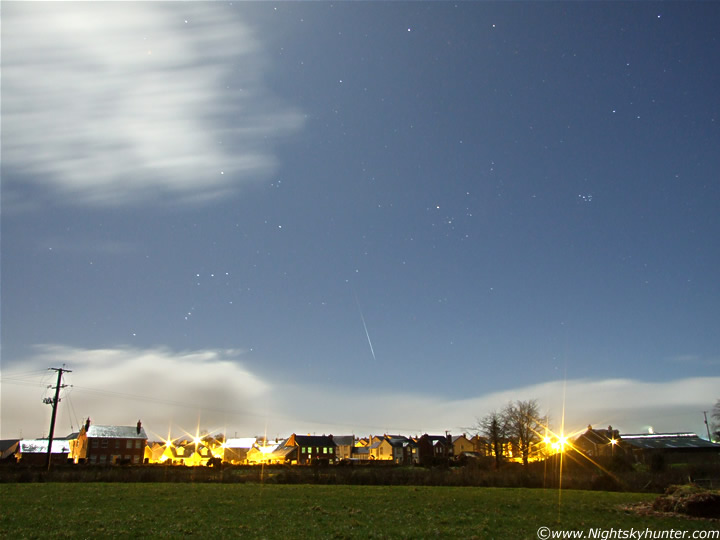 |
I got set-up in a field and watched the sky visually for some time. I never aim the camera randomly in the sky. Instead I like to gauge where the greatest activity is occurring then concentrate my patrolling in that area. It was soon apparent that W was best. The region between Orion and the head of Cetus was producing a rich number of meteors. Another area to the NW and N was impressive but it came second place to the W. Since I had arrived here I had already seen five meteors brighter than mag +1.0, and a fireball in this area. I began taking exposures but the Moon was low and threatening to enter the frame. I was alternating between F/3.2 and F/3.6 at ISO 400 using 25 and 30 sec exposures. It was now silent, calm, and freezing. I was taking images and watching that region of sky extremely carefully. A large Owl caught my attention as it flow over my head without making a sound. I watched its dark body sailing through the sky against a background of stars. I looked back to the W and seen a mag - 4.0 borderline fireball shoot through my patrol area!. I previewed the image - I had got it!!. Zooming in I could see it was a nice trail, I felt very happy to have caught it. This was definitely the trophy catch from the night.
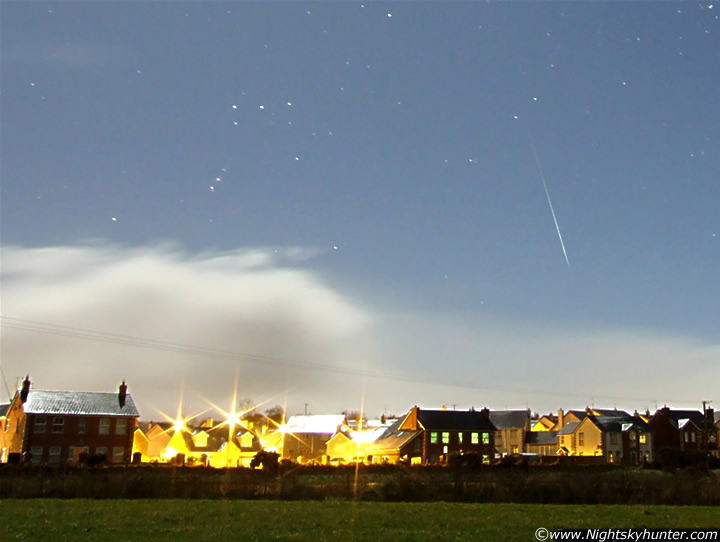 |
This is a crop from the full image. The Geminid is passing through Orion. The intense moonlight is really illuminating those frosty rooftops. The white clouds in the distance are producing light sleet showers. I was very happy with this capture.
It was now between 05.00 and 05.30 UT just a few hours before dawn. The Moon was getting lower in the W and the sky was getting darker in the E where many Geminids could now be seen. Some patchy high altitude cloud drifted in from the NW and when I looked up I could tell the atmosphere was covered in falling ice crystals. I knew this might generate some nice lunar optical phenomena. No sooner had I thought this when I spotted a segment of 22 degree halo around the Moon. This quickly faded away and was followed by a wonderful lunar upper tangent arc which extended for some distance as a coloured, straight, horizontal bar. This soon faded from view so I went back to meteor watching again. I turned around 180 degrees and looked into the E and got a shock. There was a strange looking arc in the sky, only this was directly opposite the Moon!.
At first it looked like a brilliant arc of white light in the NE, this faded and was followed by another in the E. Then both merged together forming a glorious curve of white across much of the sky. I could see some red and blue colour in places but white was the dominating one. Other than the Moon itself this was the brightest phenomena in the sky!. It was visible for a long time so I observed and imaged it at my leisure. There was a bright patch at the centre of the curve with another arc extending upwards from this in a 'cross' fashion. I suspected it to be some kind of parry arc but I wasn't sure. I contacted atmospheric expert Les Cowley for help. Les came back to me with the answer. What I had seen was a rare lunar parhelic circle (paraselenic circle to be precise) and an even more rare Wegener arc. He very kindly used the images as an OPOD on his site where he explains the phenomena much better than I could. I was delighted to have seen this display because I have always had an interest in atmospheric phenomena for a long time and have always been on the look out for rare events. In over ten years of observing I have never seen a Wegener Arc before. This made the long night worth it!
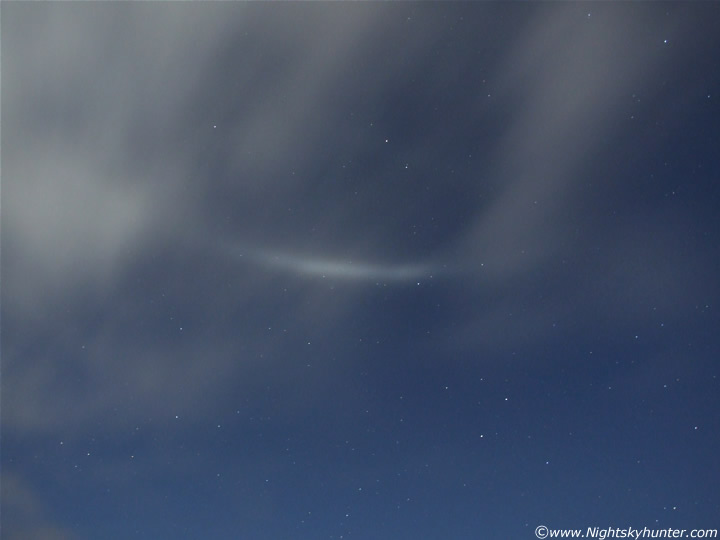 |
This is the paraselenic circle when it first appeared in the NE. This is just a segment. Ursa Minor to the upper L and Draco below.
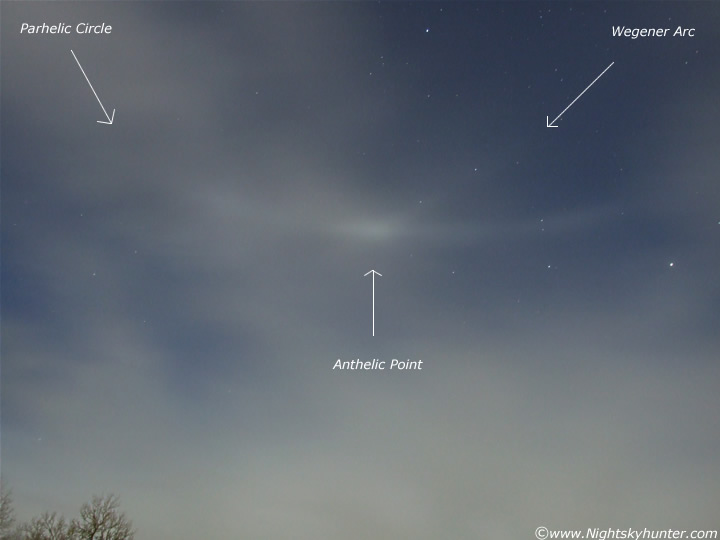 |
Annotated image showing all three phenomena. Arcturus is the bright star to the R.
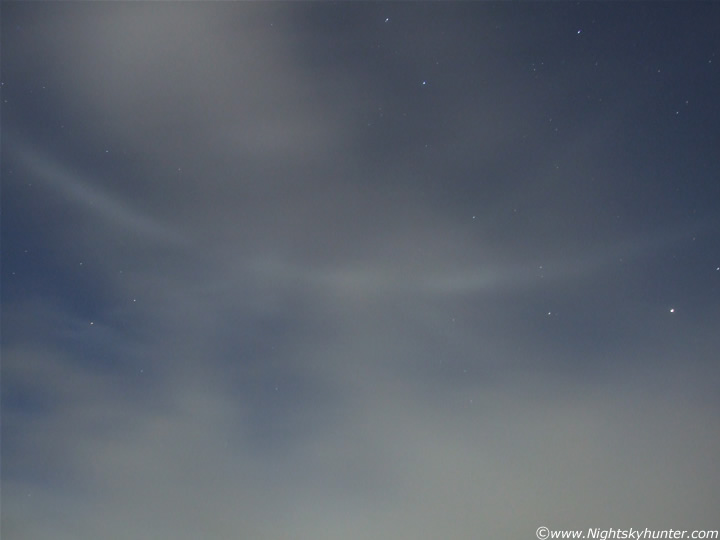 |
Complete arc. This was over 120 degrees wide. It was such a shock to see something like this when the Moon was in the W. I was indeed very fortunate to have been out tonight.
These strange arcs had stole my attention for a while so I had to get back into meteor mode. The activity seemed to reach its peak just before dawn with a great abundance of meteors in the E and NE. Then the most incredible Geminid fireball I have seen since the 2006 Leonid meteor shower burned up in spectacular fashion!. This entered the atmosphere high in the W, shot through the zenith above my head, and burned up in the E. The head of this awesome fireball was several times the diameter of the full Moon and sported the most stunning deep purple colour the likes of which I have never seen before. Behind this was a glorious straight white tail crossing the entire sky for more than 100 degrees with several vivid linear streamers running along it's entire length. This fireball was absolutely breathtaking and gave the impression of a great comet. I just stood there, shocked, looking at that area of sky where it had vanished. There was nothing but stars now, had this fireball been a dream?, it sure felt like it. This was the highlight of the night and a sight I will never forget. Just one words describes it - Wow!.
I attached the super wide angle conversion lens to widen my search area then continued patrolling in the NE and E sky for more fireballs. The activity did seem to be on the wane now with only a few mag +2.0 meteors on show. With the chirping of a few early birds and a brightening twilight sky I decided to call it a night. It was now 07.00 UT. I had been out in the frost for seven hours. I began to wonder as I went to bed if other observers had seen this great activity. The following day it was confirmed. Bright Geminids and fireballs were reported in various locations around the world with a ZHR of 160 meteors per hour which is quite remarkable. Keeping in mind that this was under a near full Moon!. What a night it was. This report was typed up in a hurry but I hope it captures what the night was like. Thanks for reading.
Martin McKenna